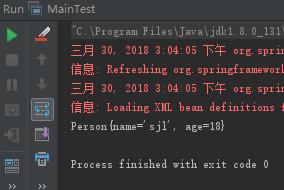面试题@Component和@Bean的区别
Posted 赵广陆
tags:
篇首语:本文由小常识网(cha138.com)小编为大家整理,主要介绍了面试题@Component和@Bean的区别相关的知识,希望对你有一定的参考价值。
个人回答:
1.作用对象不同:@Component 注解作用于类,而 @Bean 注解作用于方法、
2.@Component 通常是通过路径扫描来自动侦测以及自动装配到 Spring 容器中(我们可以使用 @ComponentScan 注解定义要扫描的路径从中找出标识了需要装配的类自动装配到 Spring 的 bean 容器中)。@Bean 注解通常是我们在标有该注解的方法中定义产生这个 bean,
@Bean 告诉了 Spring 这是某个类的实例,当我们需要用它的时候还给我。
3.@Bean 注解比 @Component 注解的自定义性更强,而且很多地方我们只能通过 @Bean 注解来注册 bean。比如当我们引用第三方库中的类需要装配到 Spring 容器时,只能通过 @Bean 来实现。
@bean的作用范围singleton prototype request session global session后面几个和当初servlet作用域差不多
生命周期:init-method destroy-method
注解中@Component和@Bean的区别
实体 POJO
public class Person {
private String name;
private Integer age;
public Person() {
}
public Person(String name, Integer age) {
this.name = name;
this.age = age;
}
// 省略 getter setter
// 后续会省略 toString 方法, 使用 IDE 自动生成就可以了
@Override
public String toString() {
return "Person{" +
"name='" + name + '\\'' +
", age=" + age +
'}';
}
}
xml 配置方式
<bean id="person" class="me.sjl.bean.Person">
<property name="age" value="18"/>
<property name="name" value="sjl"/>
</bean>
测试代码
public static void main(String[] args) {
ApplicationContext ctx = new ClassPathXmlApplicationContext("classpath:/applicationContext.xml");
Person person = (Person) ctx.getBean("person");
System.out.println(person);
}
测试结果

bean 创建成功
以上是我们使用传统的 xml 配置方式创建一个 bean 的方式,下面我们使用注解来创建一个 bean。
@Bean
JavaConfig 方式
@Configuration
public class BeanConfig {
@Bean
public Person person() {
return new Person("SJL01", 20);
}
}
在配置类上打个一个 @Configuration 注解,表示声明该类为 Spring 的配置类。在创建一个方法,方法返回对象即我们要创建的对象 Person , 返回该对象的实例。在方法上打上注解 @Bean即表示声明该方法返回的实例是受 Spring 管理的 Bean。
测试代码
@Test
public void test2() {
ApplicationContext ctx = new AnnotationConfigApplicationContext(BeanConfig.class);
Person person = ctx.getBean(Person.class);
System.out.println(person);
}
结果

使用注解方法创建 bean 成功
这里使用的是 AnnotationConfigApplicationContext() 类,传入参数就是 配置类
@Bean 注解的属性解析
value
name
name 和 value 两个属性是相同的含义的, 在代码中定义了别名。 为 bean 起一个名字,如果默认没有写该属性,那么就使用方法的名称为该 bean 的名称
autowire
装配方式 有三个选项
Autowire.NO (默认设置)
Autowire.BY_NAME
Autowire.BY_TYPE
指定 bean 的装配方式, 根据名称 和 根据类型 装配, 一般不设置,采用默认即可
initMethod
bean 的初始化方法, 直接指定方法名称即可,不用带括号
@Configuration
public class BeanConfig {
@Bean(initMethod = "init")
public Person person() {
return new Person("SJL01", 20);
}
}
Person 类添加 init() 方法
public void init() {
System.out.println("init ............");
}
destroyMethod
bean 的销毁方法, 在调用 IoC 容器的 close() 方法时,会执行到该属性指定的方法。不过,只是单实例的 bean 才会调用该方法,如果是多实例的情况下,不会调用该方法
@Bean(destroyMethod = "destroy")
public Person person() {
return new Person("SJL01", 20);
}
Person 类添加 destroy() 方法
public void destroy() {
System.out.println(" destroy ...............");
}
两者的目的是一样的,都是注册bean到Spring容器中
1、@Component注解表明一个类会作为组件类,并告知Spring要为这个类创建bean。
2、@Bean注解告诉Spring这个方法将会返回一个对象,这个对象要注册为Spring应用上下文中的bean。通常方法体中包含了最终产生bean实例的逻辑。
区别:
1、@Component(@Controller、@Service、@Repository)通常是通过类路径扫描来自动侦测以及自动装配到Spring容器中。
2、而@Bean注解通常是我们在标有该注解的方法中定义产生这个bean的逻辑。
3、@Component 作用于类,@Bean作用于方法
Spring帮助我们管理Bean分为两个部分
- 一个是注册Bean(@Component , @Repository , @ Controller , @Service , @Configration),
- 一个装配Bean(@Autowired , @Resource,可以通过byTYPE(@Autowired)、byNAME(@Resource)的方式获取Bean)。
完成这两个动作有三种方式,一种是使用自动配置的方式、一种是使用JavaConfig的方式,一种就是使用XML配置的方式。
@Compent 作用就相当于 XML配置
@Component
public class Student {
private String name = "lkm";
public String getName() {
return name;
}
public void setName(String name) {
this.name = name;
}
}
@Bean 需要在配置类中使用,即类上需要加上@Configuration注解
@Configuration
public class WebSocketConfig {
@Bean
public Student student(){
return new Student();
}
}
两者都可以通过@Autowired装配
@Autowired
Student student;
那为什么有了@Compent,还需要@Bean呢?
如果你想要将第三方库中的组件装配到你的应用中,在这种情况下,是没有办法在它的类上添加@Component注解的,因此就不能使用自动化装配的方案了,但是我们可以使用@Bean,当然也可以使用XML配置。
以上是关于面试题@Component和@Bean的区别的主要内容,如果未能解决你的问题,请参考以下文章